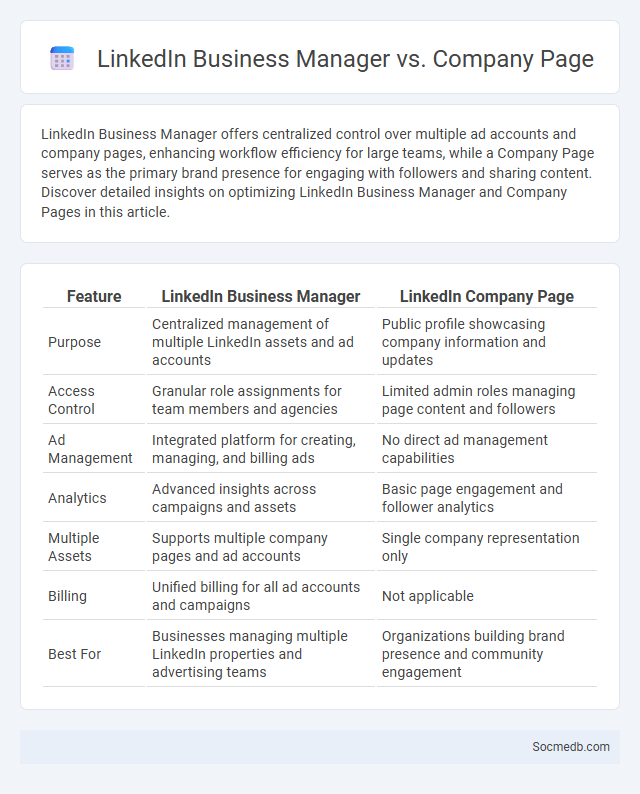
Photo illustration: LinkedIn Business Manager vs Company Page
LinkedIn Business Manager offers centralized control over multiple ad accounts and company pages, enhancing workflow efficiency for large teams, while a Company Page serves as the primary brand presence for engaging with followers and sharing content. Discover detailed insights on optimizing LinkedIn Business Manager and Company Pages in this article.
Table of Comparison
| Feature | LinkedIn Business Manager | LinkedIn Company Page |
|---|---|---|
| Purpose | Centralized management of multiple LinkedIn assets and ad accounts | Public profile showcasing company information and updates |
| Access Control | Granular role assignments for team members and agencies | Limited admin roles managing page content and followers |
| Ad Management | Integrated platform for creating, managing, and billing ads | No direct ad management capabilities |
| Analytics | Advanced insights across campaigns and assets | Basic page engagement and follower analytics |
| Multiple Assets | Supports multiple company pages and ad accounts | Single company representation only |
| Billing | Unified billing for all ad accounts and campaigns | Not applicable |
| Best For | Businesses managing multiple LinkedIn properties and advertising teams | Organizations building brand presence and community engagement |
Introduction to LinkedIn Business Tools
LinkedIn Business Tools enhance professional networking by providing features such as advanced analytics, targeted advertising, and content management to optimize company presence. These tools enable businesses to connect with industry leaders, recruit talent, and engage potential clients through personalized campaigns. Leveraging LinkedIn's platform increases brand visibility and drives strategic growth in the competitive social media landscape.
What is LinkedIn Business Manager?
LinkedIn Business Manager is a centralized platform designed for businesses to manage multiple LinkedIn Pages, ad accounts, and team permissions efficiently. It offers streamlined control over campaign management, billing, and access roles, enhancing collaboration between marketing teams and agencies. By providing granular user permissions and consolidated account management, LinkedIn Business Manager improves workflow and security for corporate social media efforts.
What is a LinkedIn Company Page?
A LinkedIn Company Page is a dedicated profile for businesses and organizations to showcase their brand, share updates, and engage with their professional audience. It allows you to highlight your company's values, products, services, job opportunities, and industry insights, enhancing your online presence. Creating and maintaining a LinkedIn Company Page helps your business build credibility, attract potential clients, and connect with industry professionals.
Key Features of LinkedIn Business Manager
LinkedIn Business Manager streamlines your company's social media management by consolidating multiple LinkedIn Pages and ad accounts into a single dashboard for efficient oversight. It offers advanced access controls, allowing you to assign roles and permissions to team members while maintaining security and accountability. With detailed analytics and reporting tools, you can monitor campaign performance, optimize engagement, and enhance Your marketing strategy on LinkedIn.
Key Features of LinkedIn Company Page
LinkedIn Company Pages offer key features such as customizable company profiles, showcasing your brand identity with logos, banners, and detailed business information. You can publish updates, share industry insights, and engage directly with followers through advanced analytics to track performance and improve your content strategy. The platform supports job postings, employee advocacy, and targeted advertising to help your business grow its professional network effectively.
Differences Between Business Manager and Company Page
Business Manager provides a centralized platform for managing multiple Facebook assets, including ad accounts, Pages, and team permissions, streamlining collaborations within your organization. A Company Page serves as your public-facing profile to connect with customers through posts, updates, and interactions, directly representing your brand. You can use Business Manager to control access and advertising efforts for one or more Company Pages, ensuring organized and secure management.
Use Cases: When to Use Business Manager vs Company Page
Business Manager is essential for managing multiple ad accounts, Pages, and team permissions efficiently in larger organizations or agencies. Company Pages serve as the public-facing profile to engage audiences, share content, and build brand presence on platforms like Facebook and LinkedIn. Use Business Manager for ad campaigns, role-based access, and asset organization, while Company Pages focus on audience interaction and organic growth.
Managing Teams and Permissions
Effective management of social media teams requires clear role assignment and permission settings to enhance collaboration and security. Utilizing tools like granular access controls in platforms such as Facebook Business Manager or Hootsuite allows administrators to define specific roles, minimizing the risk of unauthorized content posting or data breaches. Regular review and updating of permissions ensure alignment with team structure changes and adherence to organizational policies.
Advertising Capabilities: Business Manager vs Company Page
Business Manager offers advanced advertising capabilities, allowing businesses to manage multiple assets, assign roles, and create targeted ad campaigns with detailed audience segmentation across platforms. A Company Page provides basic advertising tools, suitable for promoting individual posts and engaging with followers but lacks comprehensive management features found in Business Manager. Utilizing Business Manager enables more efficient budget control, in-depth analytics, and streamlined campaign optimization for larger or multi-brand enterprises.
Which One Is Right for Your Business?
Choosing the right social media platform depends on your target audience, business goals, and content type. Instagram excels for visual brands targeting younger demographics, while LinkedIn is ideal for B2B connections and professional networking. Your decision should align with where your customers spend their time and how you plan to engage them effectively.
 socmedb.com
socmedb.com